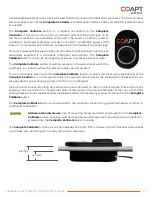
HANDBOOK (V
4.0)
COMPLETE CONTROL SYSTEM GEN2
13
A HELPFUL APPROACH TO LEADING THIS DISCUSSION:
•
Ask questions to determine what movements the user can perceive and produce with
their phantom limb, such as:
o
“Can you feel your hand? Which fingers do you feel you can move?”
o
“Can you imagine making a fist? What about opening your hand with your fingers
spread apart?”
o
“Does it feel like your hand is squeezing down on something?”
o
“Do you feel like you can turn your wrist? Does your hand stay relaxed?”
o
“Does your thumb move? How far? Which direction?”
o
… and so on. Remember, the goal is to learn together what more might be available
for control with more multi-site contacts.
•
When you have your user perceive these motions, ask that they hold them at a medium
intensity and for about 3-4 seconds each. This is good practice for the eventual
prosthesis controls’ (and users’ self-led) calibration procedure.
•
Encourage the user to mirror their perceived motions with their sound limb if possible.
•
Start the discussion with the most intuitive motions and add variations as needed; i.e.
try natural hand close for “hand close” and if they have poor perception of hand close
but good perception of one specific finger (for example), try practicing the use of that
finger perception for “hand close.” In another example, if wrist rotation is difficult to
perceive, discuss the feeling of adding thumb or pinky finger ab/adduction to
accentuate rotation.
•
Focus on motions that are distinct and repeatable.
•
Take considerable time with this process.
•
Be patient and listen.
•
Perform this discussion in a relaxed environment.
•
Develop a common vocabulary for specific motions.
















































